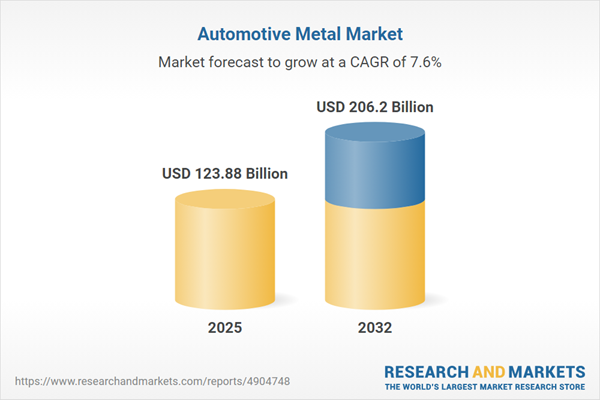Speak directly to the analyst to clarify any post sales queries you may have.
The automotive metal market is experiencing a pivotal shift fueled by ongoing material innovations, digital manufacturing advances, and heightened focus on sustainability across supply chains. As global regulations and electrification trends gain momentum, executive decision-makers require a clear and up-to-date view to inform their next strategic moves.
Market Snapshot: Automotive Metal Market Size and Trajectory
The automotive metal market grew from USD 114.98 billion in 2024 to USD 123.88 billion in 2025. With a projected CAGR of 7.57%, the market is expected to reach USD 206.20 billion by 2032. This sustained expansion highlights the increasing importance of metals in addressing new vehicle demands, evolving supply networks, and regulatory compliance as manufacturers navigate the transition to electrification, digitalized production, and stricter emissions standards.
Scope & Segmentation: In-Depth Market Coverage
- Product Types: Includes a range of core automotive components such as castings (aluminum, iron, magnesium), forgings (closed die, open die, ring), and sheet metal (cold rolled steel, hot rolled steel, stainless steel). Stamped components are also integral, encompassing panels, reinforcements, and structural elements essential for various vehicle models.
- Vehicle Categories: Covers commercial vehicles (heavy and light), passenger segments (hatchback, MPV, sedan, sport utility vehicle), as well as two wheelers (motorcycle, scooter). Each category is affected differently by automation, emissions policy, and consumer preferences across global regions.
- Applications: Addresses applications from body structure (inner frameworks, outer panels), to chassis elements (axle, subframe), and interior components (decorative trim, functional features). Powertrain requirements also play a crucial role, with engine and transmission components increasingly optimized for performance and efficiency.
- Material Types: Focuses on lightweight and high-performance metals, including aluminum (cast, wrought), magnesium (die cast, wrought), steel (carbon, stainless), and titanium (pure, alloyed). Material choice is strongly influenced by application, innovation cycles, and sustainability goals, shaping supplier strategies and capital investment priorities.
- Regions: Geographical coverage encompasses the Americas (North America, Latin America), EMEA (Europe, Middle East, Africa), and Asia-Pacific (China, India, Japan, Australia, South Korea, Southeast Asia). Regional dynamics shape investment flows and technology adoption rates.
- Leading Companies: Market leadership features firms such as Ulbrich Stainless Steels & Special Metals, thyssenkrupp Materials NA, H & S Manufacturing, Steel Warehouse Company, Gestamp Automoción, Versa-Bar, Worthington Industries, Arbor/Metals, Mills Products, and Drawn Metal Tube Company. Their roles are fundamental in both supply continuity and innovation deployment.
Key Takeaways for Senior Decision-Makers
- Deployment of lightweight alloys and sophisticated high-strength steels is essential for manufacturers to meet efficiency, safety benchmarks, and comply with emerging emissions requirements.
- Integration of advanced manufacturing technologies—such as additive manufacturing, laser welding, and precision stamping—enables the production of complex geometries and supports customized, scalable output.
- Environmental considerations have led to intensified prioritization of end-of-life recycling, comprehensive lifecycle analysis, and closed-loop production systems throughout automotive metal operations.
- Cross-sector collaboration between raw material providers, OEMs, and research laboratories is helping accelerate innovation and the commercialization of next-generation automotive solutions.
- Distinct regional strategies prevail: North American market participants focus on supply chain resilience and local sourcing, while European firms highlight sustainability through carbon reduction and recycling. Asian companies are prominent for rapid innovation and global partnerships, adapting agilely to new manufacturing paradigms.
Tariff Impact Across the Automotive Metal Supply Chain
Recent U.S. tariff developments have disrupted legacy procurement models and exerted upward pressure on material costs sector-wide. In response, automotive manufacturers are recalibrating sourcing strategies, renegotiating supplier agreements, and evaluating nearshoring or regional alternatives. Long-term supply contracts and proactive risk management practices are becoming vital measures to help stabilize the automotive metal supply chain and maintain operational continuity.
Methodology & Data Sources
This report is based on a comprehensive methodology using primary interviews with senior industry experts and rigorous secondary analysis of authoritative publications, regulatory updates, and company communications. Supplementary quantitative insights come from proprietary databases monitoring global trade flows and production shifts, all validated by panels of sector specialists to ensure dependable results.
Why This Report Matters for Automotive Metal Market Stakeholders
- Provides deep, segment-focused insights to support strategic investment and planning, encompassing current technologies, geographic distinctions, and application areas.
- Equips organizations to recognize and proactively manage risks and opportunities arising from regulatory changes, emerging manufacturing advancements, and sustainability imperatives.
Conclusion
Senior leaders who leverage incisive, data-backed intelligence on the automotive metal market will be well placed to adapt effectively as sector dynamics shift. Understanding multidimensional trends is crucial to safeguarding competitiveness in the evolving industry landscape.
Additional Product Information:
- Purchase of this report includes 1 year online access with quarterly updates.
- This report can be updated on request. Please contact our Customer Experience team using the Ask a Question widget on our website.
Table of Contents
3. Executive Summary
4. Market Overview
7. Cumulative Impact of Artificial Intelligence 2025
List of Figures
Samples

LOADING...
Companies Mentioned
The key companies profiled in this Automotive Metal market report include:- Ulbrich Stainless Steels & Special Metals, Inc.
- thyssenkrupp Materials NA, Inc.
- H & S Manufacturing Co.
- Steel Warehouse Company LLC
- Gestamp Automoción, S.A.
- Versa-Bar, Inc.
- Worthington Industries, Inc.
- Arbor/Metals Inc.
- Mills Products, Inc.
- Drawn Metal Tube Company
Table Information
| Report Attribute | Details |
|---|---|
| No. of Pages | 198 |
| Published | October 2025 |
| Forecast Period | 2025 - 2032 |
| Estimated Market Value ( USD | $ 123.88 Billion |
| Forecasted Market Value ( USD | $ 206.2 Billion |
| Compound Annual Growth Rate | 7.5% |
| Regions Covered | Global |
| No. of Companies Mentioned | 11 |









